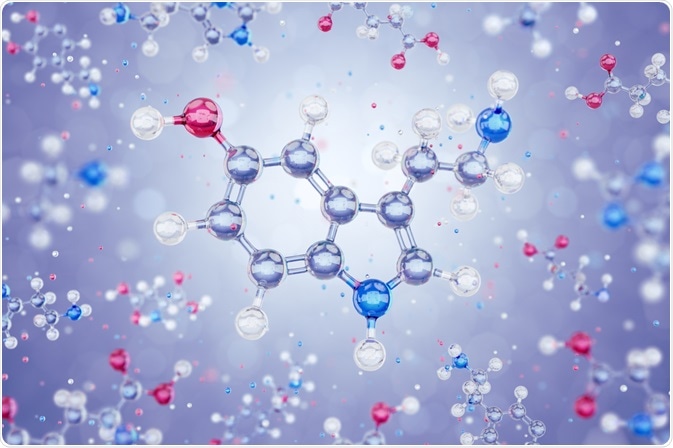Every cell synthesizes an array of metabolites that take part in various metabolic reactions. The metabolome constitutes a complete set of small-molecule chemicals found within biological samples. These compounds are involved in various biochemical reactions that are essential for the growth and normal functioning of cells, which in turn, determine the final phenotype of an organism. Besides, small molecules, other compounds are associated with the metabolome are fatty acids, vitamins, lipids, amino acids, etc.

Image Credit: Sergey Tarasov/Shutterstock.com
The metabolome changes constantly owing to the varied chemical reactions that take place in a cell. Just as genomics is the study of DNA and transcriptomics is the study of RNA, the large-scale study of metabolome is called metabolomics. It usually studies small molecules that have a mass in the range of 50 – 1500 Daltons (Da).
What are small molecules?
Metabolites or small molecules are molecules that have a low molecular weight and are often involved in varied biological processes, either as a product or as a substrate. Some examples of small molecules are sugars, fatty acids, lipids, phenolic compounds, alkaloids, etc. Metabolites show a vast range of variations.
Research has shown that plants are biochemically quite rich, compared to other species, and the plant kingdom alone has about 200,000 metabolites. The number of metabolites in humans is much less. The estimates of the number of metabolites must be considered to be lower bounds as it can be very challenging to identify low-abundance molecules.
Identification of metabolites
There have been significant technological innovations, which have led to the availability of platforms for performing metabolomics. Liquid chromatography/mass spectrometry (LC/MS) is the most commonly used platform for discovery experiments. The greatest challenge is translating signals, from the metabolic extract of a biological sample to metabolite identities. This identification process is still quite a throughput and it is quite common to analyze the same metabolomics data for weeks or even months.
Even at the end of this arduous process, only a small number of identifications (<20) are typically made. There are hundreds or thousands of unknown metabolites to which the signals of LC/MS may correspond, and this is precisely the exciting and challenging aspect of performing discovery metabolomics.
To identify a metabolite a few metrics are used together, namely, chromatographic retention time, isotopic pattern, fragmentation data, and mass-to-charge value. It is highly unlikely that two metabolites will have the same combination of the above-mentioned parameters. Researchers have pointed that retention time and fragmentation data may lead to some experimental challenges.
Currently, cloud computing is available to conduct metabolomics analysis. The most widely used software is XCMS. Data are uploaded, processed, and integrated with the METLIN database, which helps in the identification of metabolites. Currently, the METLIN database contains fragmentation data for more than 12000 model standards. Researchers are trying to further integrate XCMS and METLIN. This will aid in the identification of metabolites based on mass-to-charge values and fragmentation data.
The use of metabolome to identify diseases
Despite extensive research on metabolomics refinement, our understanding of what constitutes the human metabolome needs much more development. Scientists have estimated the number of small molecules in the human body exceeds 19000, which includes metabolites food, medications as well as those derived from the body’s innate functions.
Besides the endogenous metabolites, it is crucial to account for the exogenous metabolites as well. Broadening the horizon for research enhances difficulties but it also opens up exciting new opportunities for discovery. The metabolome is almost surely likely to change with the incidence of diseases and, therefore, metabolomics can help in the detection of an array of diseases.
Metabolites can be reporters of disease as their presence could be correlated with pathogenic mechanisms. Sophisticated metabolomics techniques that are available in the present day can speed up the process of discovery of markers associated with disease and validation of these metabolic indicators of disease.
There has been some recent success in this field, i.e., detection of early metabolic indicators, many years before the onset of clinical symptoms, in pancreatic cancer, type 2 diabetes, memory impairment, etc.
Importance of metabolomics
Recent advances in the study of the metabolome have led to the application of metabolomics in several fields, such as biology and biomedical research. Recently, researchers have combined cell biology with lipidomics to study the role of lipids in cytokinesis, which is the cytoplasmic division of a cell at the end of mitosis or meiosis and, thereby, resulting in two daughter cells.
New RNA modifications have also been documented, using metabolomics. Scientists have used metabolomics to purify cellular RNAs by removing small molecules. Subsequently, the RNA was digested and compared to a sample treated with an inactive nuclease P1. This provided novel evidence of NAD-linked RNA in E.coli and Streptomyces venezuelae.
Metabolomics has also influenced cancer biology. Together with metabolic flux analysis, it has helped scientists understand the contribution of aerobic glycolysis to the cancer phenotype.
Metabolomics has also helped scientists gauge the extent of glucose utilization in cancer cells and identify the role of different genes associated with cancer. It can be confidently said that metabolomics and metabolomics flux analysis are helping scientists gain a better understanding of numerous biological problems.
With further research, we will gain a better understanding of the role of metabolism in orchestrating and regulating a myriad of biological processes. This is particularly exciting for disease biology as it can open up many new therapeutic opportunities.
Sources:
- Metabolomics. EMBL-EBI.(2021). [Online] Available at: www.ebi.ac.uk/.../
- Clish C. B. (2015). Metabolomics: an emerging but powerful tool for precision medicine. Cold Spring Harbor molecular case studies, 1(1), a000588. https://doi.org/10.1101/mcs.a000588
- Zamboni, N., Saghatelian, A., and Patti, G. J. (2015). Defining the metabolome: size, flux, and regulation. Molecular cell, 58(4), pp. 699–706. https://doi.org/10.1016/j.molcel.2015.04.021
Further Reading